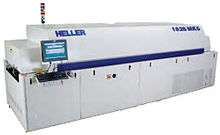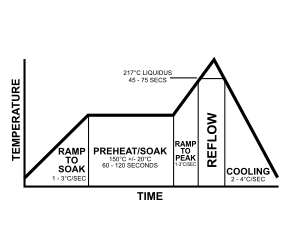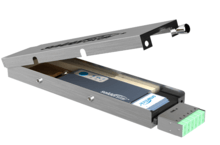Reflow oven
A reflow oven is a machine used primarily for reflow soldering of surface mount electronic components to printed circuit boards (PCB).
Types of reflow ovens
Infrared and convection ovens


The oven contains multiple zones, which can be individually controlled for temperature. Generally there are several heating zones followed by one or more cooling zones. The PCB moves through the oven on a conveyor belt, and is therefore subjected to a controlled time-temperature profile.
The heat source is normally from ceramic infrared heaters, which transfers the heat to the assemblies by means of radiation. Ovens which also use fans to force heated air towards the assemblies (which are usually used in combination with ceramic infrared heaters) are called infrared convection ovens.
Some ovens are designed to reflow PCBs in an oxygen-free atmosphere. Nitrogen (N2) is a common gas used for this purpose. This minimizes oxidation of the surfaces to be soldered. The nitrogen reflow oven takes a few minutes to reduce Oxygen concentration to acceptable levels within the chamber. Thus nitrogen ovens typically have nitrogen injection in at all times which decreases defect rates.[1]
Vapour phase oven
The heating of the PCBs is sourced by thermal energy emitted by the phase transition of a heat transfer liquid (e. g. PFPE) condensing on the PCBs. The liquid used is chosen with a desired boiling point in mind to suit the solder alloy to be reflowed.
Some advantages of vapour phase soldering are:
- High energy efficiency due to the high heat transfer coefficient of vapour phase media
- Soldering is oxygen-free. There is no need for any protective gas (e.g. nitrogen)
- No overheating of assemblies. The maximum temperature assemblies can reach is limited by the boiling point of the medium.
This is also known as condensation soldering.
Thermal profiling
Thermal profiling is the act of measuring several points on a circuit board to determine the thermal excursion it takes through the soldering process. In the electronics manufacturing industry, SPC (statistical process control) helps determine if the process is in control, measured against the reflow parameters defined by the soldering technologies and component requirements. [2] [3]

See also
References and further reading
- Girouard, Roland. "Mark5 Reflow Oven". Heller Industries Website. Heller Industries Inc. Retrieved 28 September 2012.
- "Guidelines for Temperature Profiling for Mass Soldering Processes (Reflow & Wave)" (PDF). Retrieved 2019-07-01.
- "Modern thermal profiling device". Solderstar Website. Solderstar. Retrieved 28 September 2018.
General references
- "T.Bazouni: Reflow Soldering". Archived from the original on 2008-06-18. Retrieved 2008-04-11.